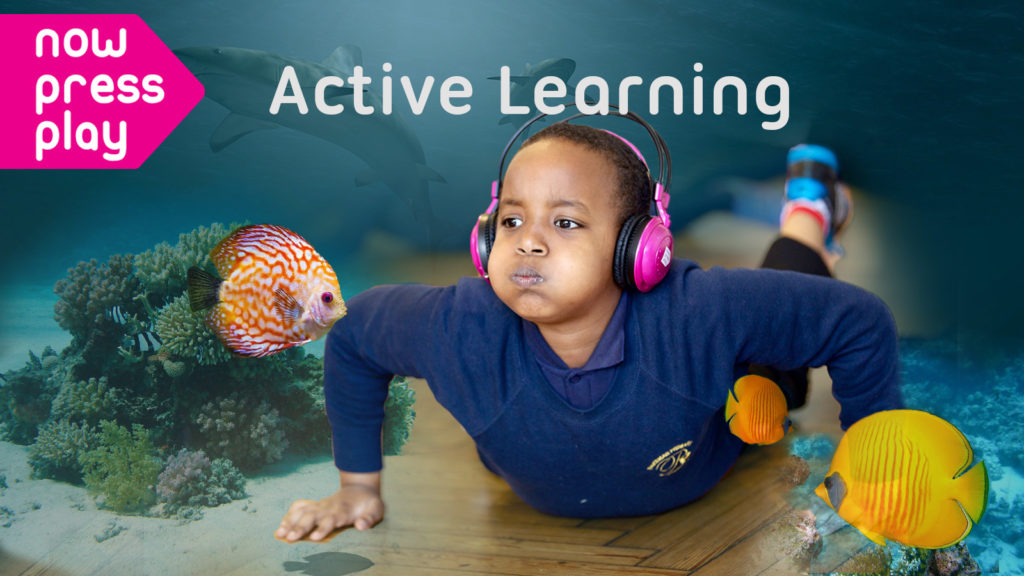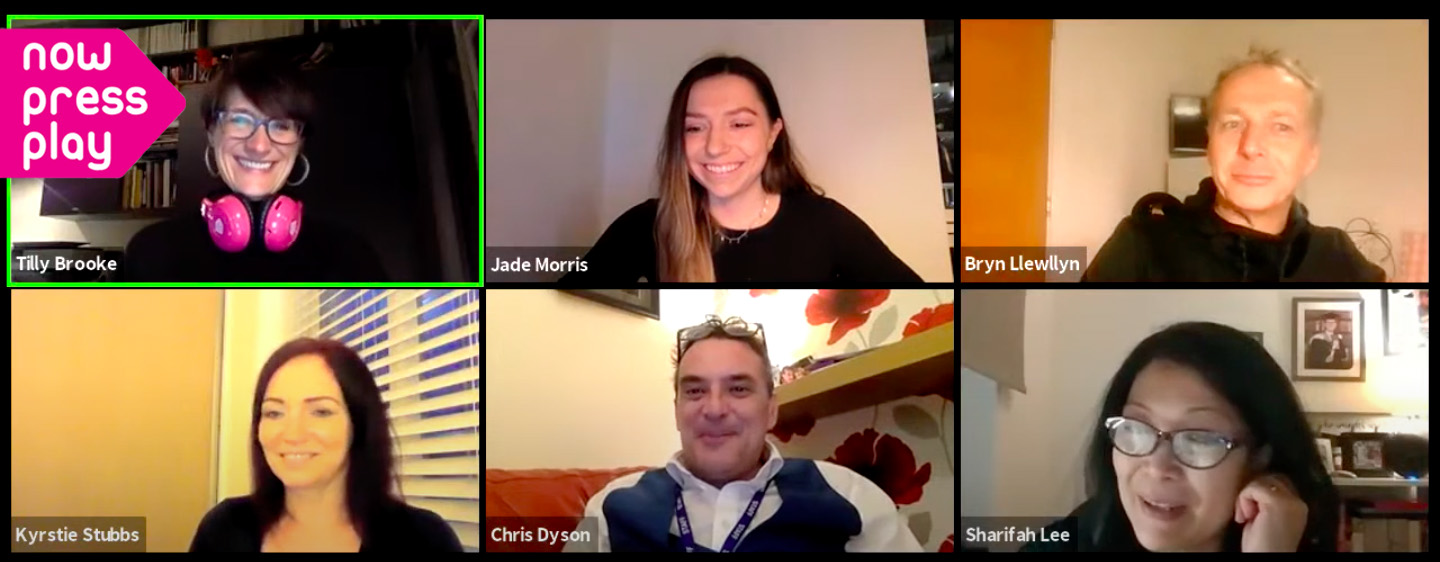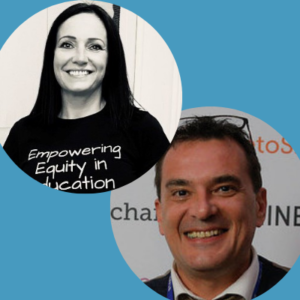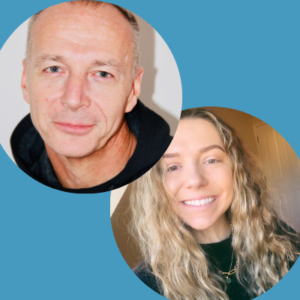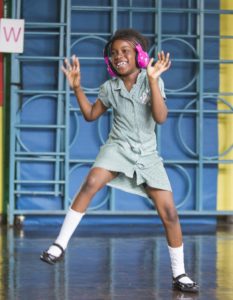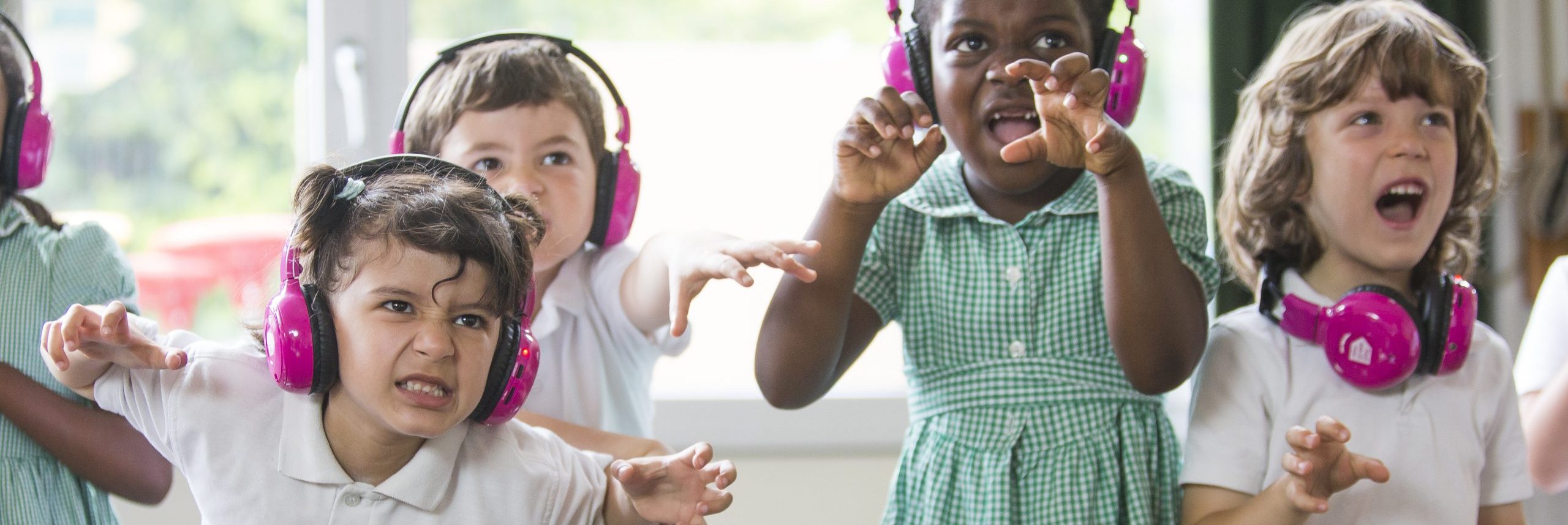
How can we embed active learning experiences into the school culture and do they really lead to greater engagement and improved outcomes?
Discover how our guest speakers approach learning through movement, how it can help attainment and support wellbeing, and some simple ideas you can get going with. We’ve curated a list of resources, key takeaways and included the recording to make it even easier for you to access their insights. You’ll leave feeling inspired with a new perspective on active learning and how to embed it in your school.
Contents:
- Webinar Recording
- Guest Speakers
- Key Takeaways
- Resources
- now>press>play & active learning (free trial)
Webinar Recording:
Webinar Guest Speakers:
 Sharifah Lee – Acting Head at Dorney School @Sharifahlee4
Sharifah Lee – Acting Head at Dorney School @Sharifahlee4
“I am an Acting Head of a beautiful village school. I know that teaching is the best job in the world! I feel that I have been teaching all my life and will never stop. Eradicating inequality and disadvantage have been a lifelong passion. A life of certain privileges means that I can use these to influence, make an impact and difference.
I have been involved in a few grassroots organisations including Education for Anti-racism and LGBTQ Early Years and am an active follower of WomenEd and DiverseEd. I am also a presenter on Teacher Hug Radio’s Childhood Chatter. A mother of four young adults, my passion is equity, equality, diversity, leadership, and professional development. I have an MA from the University of Manchester, am currently working towards my NPQH (women only cohort) and have been awarded with a Fellowship from the Chartered College of Teaching.”
 Kyrstie Stubbs – Principal at Boothroyd Primary Academy @KyrstieStubbs
Kyrstie Stubbs – Principal at Boothroyd Primary Academy @KyrstieStubbs
Kyrstie is Principal of a large Primary School in West Yorkshire with over 600 pupils, part of Focus Trust. The school has improved dramatically over the past few years and is now recognised for their outstanding work regarding inclusivity and mental health & wellbeing.
They are currently on a mission to ensure that there is better representation in their school and curriculum, educating their children to be effective allies.
Chris Dyson – Headteacher at Parklands Primary School @chrisdysonHT
Chris Dyson is the headteacher at Parklands Primary, situated on one of Europe’s largest council estates in Leeds. One of the most deprived schools in Leeds, with 74% Pupil Premium, when Chris arrived at the school 7 years ago, it had been deemed inadequate and had 150 exclusions in a year. Today exclusions are zero, the school has the highest progress score for maths in the country, and Ofsted has recently judged the school outstanding.
Chris still has largely the same team as when he arrived, but has changed the culture of the school, with the proverbial “carrot” being used rather than a stick, coaching used with staff, and the wellbeing of staff and children becoming the driving force. Chris is now an NLE and sharing the story of how he achieved this transformation with leaders from other schools.
During lockdown he distributed over 100000 meals (including 36000 in 3 hours – 19 tonnes) and sourced over 350 laptops and iPads for all his school community.
He can also be found sharing joy, excitement and positively aplenty on Twitter at @ChrisDysonHT
 Bryn Llewelyn – Founder of Tagtiv8 and Co-founder and Director of Move & Learn (CIC) @tagtiv8
Bryn Llewelyn – Founder of Tagtiv8 and Co-founder and Director of Move & Learn (CIC) @tagtiv8
According to a Key Stage 2 pupil at Oakdale Junior School in London, Bryn is “a genius”. However, his friends and family know the truth.
Bryn worked in various UK schools for 25 years as a Teacher, Deputy Head and Acting Head. In 2012, he founded Tagtiv8. His pioneering approach to Physically Active Learning (PAL) provides an enjoyable alternative to classroom based learning and also promotes physical activity – crucial when we all face the increasing problem of sedentary lifestyles.
Bryn is also co-founder and director of Move & Learn (CIC). He acts as a consultant for the Premier League and various football foundation trusts, as well as BBC Bitesize, Supermovers & Live Lessons.
Jade Morris – Postdoc Research Associate at King’s College London @jadelynnemorris
Jade has recently stepped into a Postdoc Research Associate role at King’s College London, working on the REACH project (Resilience, Ethnicity in Adolescent Mental Health). REACH’s aim is to look at common trajectories of mental health during adolescent, looking at social and environmental factors. Previously, Jade worked and studied at Leeds Beckett University, with a background in physical activity and health. Specifically, Jade completed her PhD on the immediate effects of acute bouts of physical activity – such as The Daily Mile initiative – on primary school children’s cognition and academic performance. Jade has expertise in evaluating the efficacy and effectiveness of physical activity (and physically active learning) interventions, as well exploring practitioner perceptions of such interventions through qualitative methods.
Move to Learn Webinar Key Takeaways:
1. What does active learning mean to you?
For Chris, it is essential that different children get to experience different learning styles because every child learns in a different way. Using a kinaesthetic learning style brings out the best in people, using problem solving and role play which feeds into giving them a stimulus for writing and out of the classroom.
Jade sees it as a continuum of activities and any way we interact moving and learning, like standing up and answering a question and sitting back down to longer hour lessons that incorporate movement.
Bryn said it’s about moving with purpose, the integration of moving and learning – it could be a physical challenge followed by a thinking challenge or a physical challenge combined with a thinking challenge and the dialogue and collaboration that happens when you’re moving with others.
Sharifah agrees it’s about a purposeful environment. Looking at active learning compared to inactive learning, you can still learn while being inactive, you can learn in different ways, but it is active learning that sets no limits and leads to limitless learning.
Kyrstie uses physical activities to help create learning links and help with memory retention and meta recognition. Children remember more when they’ve been doing and it’s about really firing those links with children.
2. Remote learning during the pandemic has made active learning much harder – how have you approached this challenge? What are you doing differently?
After sorting out the digital aspects of lack of devices, the main challenge was motivating children that aren’t self motivated. Chris and Parklands School have been using things like now>press>play or Tagtiv8 on a daily basis and covering PSHE with RockKidz, as well as linking up with SportsCool and Commando Joes so that children are experiencing more activity than just PE. They’ve also marked out the daily mile so children can self motivate.
Chris just worked through the first lockdown and didn’t do his daily exercise but since lockdown 2 he’s been doing daily challenges, it’s about doing 6 minutes a day – “Because if you’re getting more physically fit, you get more mentally fit. It’s about looking after people, getting them outside and working with people again.”
Before the pandemic 4 out of 5 children were deemed insufficiently active and that’s just been exacerbated. Fine for children with gardens and parks but for every child with that there are one or two that didn’t have that – so it’s about addressing the balance and making sure that gap doesn’t get too wide.
3. There’s a big focus on catch up due to the pandemic. Some people might argue that spending time playing and moving is wasteful and that right now we need to focus on lost time learning sitting down while others argue the opposite way. What’s your response to this?
We need to flip the narrative about catch up, what children need is to catch up with their family and their friends, they need those experiences they’ve missed out on.
For those children that have been isolated, going back to school is about being active, not just academically, but physically, emotionally and mentally. Those things need to be in place before we even talk about academic catch up.
For a child to do well in a subject they excel in, they have to be in the right frame of mind mentally and we know that physical activity supports mental health.
There’s pupils, staff and parents with slightly raised anxiety. By being more active, we are giving people the energy they need to be able to discover themselves again. We need to learn what is the priority now, not just in education but in life.
It’s about how you view education. If it’s purely academic you might need to go over knowledge or repeat it but if you see education as about the whole child, the catch up focus is on the wrong thing.
We need to bring back a normal routine and take away the fear and uncertainty that they won’t do as well later on and reassure them that that is not the most important thing, it’s those other interactions that they need to get back to.
4. What is the evidence that supports learning through play and movement?
People are fearful about displacing learning time with physical time. But how much more productive you are after doing something that promotes your physical and mental wellbeing?
From a quantitative perspective there’s a positive response from teachers that there are loads of benefits outside of the physical, in terms of academic achievement; building teamwork; creating different dynamics socially and environmentally; the pupils are enjoying themselves and they’re learning in a kinaesthetic way. It helps to learn in different ways, especially those children that struggle in a traditional setting.
Physically active learning means you can transfer learning from short term to long term memory and improves the stickiness of the learning.
Children just engaging in 15 minutes of movement, even if that’s low intensity, has benefits and even simply having that break from learning from not having to focus is going to help children learn better.
Play helps to nurture and encourages imagination and once you can imagine it you can write about it and it helps develop life skills like problem solving and communication
5. Early years has a big focus on learning through play – do you think the upper key stages could benefit from this and how?
As everyone knows, the most development for a child happens in the early years and it happens through play, so it makes sense to extend the early years method through the whole school. Blend learning and take the playfulness into KS1 and KS2.
Kyrstie and her passionate early years team at Boothroyd Primary are working on several projects to do this – they’ve extended continuous provision up to Key Stage 1, have introduced small world in different Key Stages with great results.
Use play based models from foundation stages – a Move and Learn project takes chalk and combines them with run relays to teach maths.
When you’re looking at the outdoor provision, and the climbing frames for early years, it’s not just about an extra PE session by climbing they’re actually developing the muscles in their hands and fingers they need to write. If children haven’t had a piece of paper and a pencil because they haven’t gone to nursery they need to develop those muscles before they’re asked to write.
6. How can SLT ensure their curriculum promotes more active learning?
We need to overcome the barriers and the fear of displacing learning time with movement and help teachers feel confident they’re ticking off learning objectives, just in a very different way. “The children who most need support need the most movement and require the most active based learning.”
Teachers need to be more confident in their approach. It’s Important to get the whole school onboard, often there’s a champion teacher and that works really well in the short term – to make it a sustainable change and a culture change you need to get all the teachers onboard. Creating a community of support can help everyone learn by trial or error and create a system change of learning.
As leaders it’s up to us to enable teachers to teach the way they want and “Be mindful with your staff team – help them be brave.”
Look towards pioneering research like Dr Andy Daly-Smith’s research, which Jade was part of, that shows small improvements by physically active learning which over time accumulate to be massive gains. “Physical active learning works as hard as it plays.” Watch Dr Andy Daly Smith’s TEDX talk to be convinced.
It’s about the approach, not the curriculum, it’s about being more holistic – our schools and our leaders need to engage with research for us to open our minds to different possibilities. We can learn from other countries models that seem more effective with happier pupils, like perhaps some of the Scandinavian models.
Add extra playtimes into the day or ask them to come to school in their PE kit so they don’t lose time getting changed and eradicate those problems. Walking around school you’ll see different year groups wearing their PE kits and that brings a different importance and awareness to physical learning.
“The biggest revelation is coming to school in your PE kit.”
Kyrstie and Boothroyd Primary are introducing tracksuits as part of their school uniform because they’ll be more comfortable and more ready to be active without the constraints of trousers and shirts.
Try micro workouts as if you’re immobile for a long time your mind wonders.
Cycling desks would be great because the children are active all the time and it helps children keep their brains geared up. “Einstein came up with a lot of his theories while he was on his bike so if he can do it, the rest of us can.”
A sustainable school model that has quick fixes and quick wins but has that long term trajectory is the Creative Active School framework developed by Yorkshire Sport Foundation, Bradford University and Public Health England.
Encourage children to be move and learn champions and promote this way of learning.
Bring it into the staffroom as well. Boothroyd Primary do a happy Monday once every half term they make dens, mud pies, water sliding and extend that into staff meetings and have a happiness staff meeting once a half term.
Active Learning Tools, Schemes, Tips & Resources list:
What schemes or resources would you recommend for someone who wants to embed active learning more?
Tools and organisations:
- “Try a now>press>play one week free trial because if it doesn’t work for you there’s no strings and you can use your pupil premium money on it and it’s a completely innovative way of learning that has huge impact. You put the headphones on and you see what it’s actually like there. It has to be put into your curriculum and use the follow on work so it has a fun and educational purpose.” – from Chris Dyson
Arrange your trial - Bryn started Tagtiv8 through looking at tag rugby and seeing how it levelled the playing field between girls and boys and thought to himself what happens if you attach letters and numbers to the tags and then you can do anything you want to, with English and maths and now modern foreign languages. Bryn knew it would work but went directly to get evidence that showed it works as hard as it plays. Tagtiv8 Case study with Parklands Leeds
- During lockdown Pobble produced boards of 30 activities, one for each day, that were about being active and outside. These activities can engaged with equally by all pupils and communities. https://blog.pobble.com/100-non-screen-activities-for-kids
- RockKidz is giving three free assemblies a week. It’s not a traditional assembly but they’re up, they’re singing, they’re learning, they’re active.
- @LazerwarsNE which have magically cones children move round and zap and do laser quests (Outdoor activity provider who offer a range of exciting adventurous sports for schools and community groups).
- Artis Foundation which develops children’s language and communication skills by role play, so before the children sit down and start writing they’re experience and role playing. @ArtisFdn
- Cross-Curricular Orienteering helps schools unlock an active learning world where children practise their skills in any subject area whilst on the move. They provide schools with the infrastructure to not only take learning outside but to make it effective, without increasing workload. @CCOrienteering
- AmaSing – learning to sing and enjoy movement through being active, standing up and doing movements.
- The Healthy Minds Program is a cutting-edge approach to preventive psychology: building resilience, wellbeing and performance. Helps developing movement and selves so you’re ready to learn.
- Sportscool is a sports coaching company based in the North of the UK. SportsCool specialise in Physical Education Coaching for primary schools. @_Sportscool
- Commando Joe’s evidence-based Character education programmes for schools and parents, enable young people to develop life skills. @CommandoJoes
- ActivAll combines physical and mental activity to get the heart rate going and encourages hand-eye coordination and motor skill development. @Activall
Tips and tricks:
- School residentials and trips extend life experiences
- Augmented reality – gets them up and moving and immerses them in the learning. Loads of free ones
- Make it okay to be active and give them the time not to be in the classroom.
- You don’t have to go far or spend much – tap into local communities: football academies, yoga classes and preschool clubs
- It could be as a simple as a scavenger hunt or a treasure hunt and you could do it at your own pace, you could walk, you could run it, you could hop it, you could space-hopper it if you want to but it’s about that purpose – it’s about moving from one station to the next.
- Stand up desks are a brilliant idea for breaking up seated learning – even if you only have one or two desks and children can rotate during the lesson
- It’s the same with expectations re: sitting, if you have students who struggle with a chair then they could sit in a peanut that gives constant feedback for their vestibular system.
- ‘Active learning kit is part of our school uniform and worn with pride.’
- ‘Our school model it [active learning] for staff too. They do Couch 2 5K three times a week around the school groups.’
Evidence, CPD & Schemes:
- The PE umbrella podcast by Ryan Ellis looking at understanding the PE National Curriculum, Inclusive & Holistic PE, gamification of learning and planning and delivery.
- Watch Dr Andy Daly Smith’s TEDX talk for evidence on active learning and getting teachers buy in.
- Sustainable school model that has quick fixes and quick wins but has that long term trajectory Creative Active School framework can be found here.
- It makes the children want to come to school – https://www.youtube.com/watch?v=eAI1Onf2-C
Audience Responses
“Listening to this has made me realise how much I do active teaching!”
“I was thinking how could I sell the idea of bringing workout bikes into the classroom but that Einstein comment has just done it! Einstein came up with some of his best ideas riding a bike. Love it!”
“Coming into school in PE kits. I’m going to really push this in my school.”
If you haven’t already got now>press>play in your school, you can book a free trial here.
I've never seen my children more engaged than they were during our now>press>play lesson. It was so nice to see them so active, wanting to continue learning and to do more, they were so excited! Even just seeing the box of equipment sitting there unopened got their excitement levels way up. One boy in particular, who can often be disengaged in lessons, asked if he could buy the headphones online himself.
Nabilah Sayed, Year 6 teacher, Shaftesbury Primary
More free CPD Webinars:
